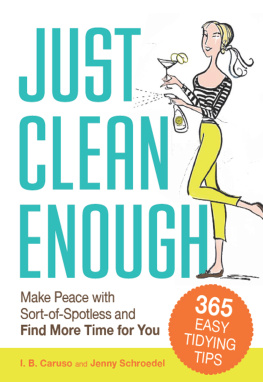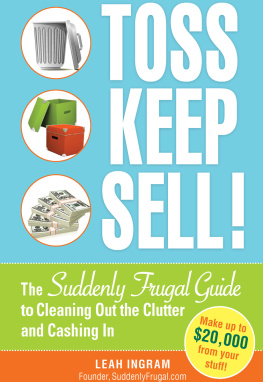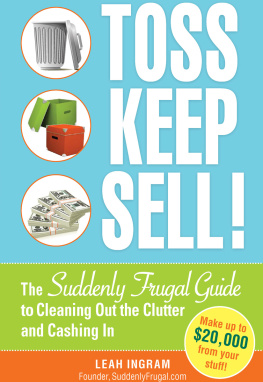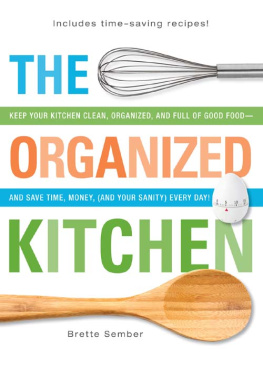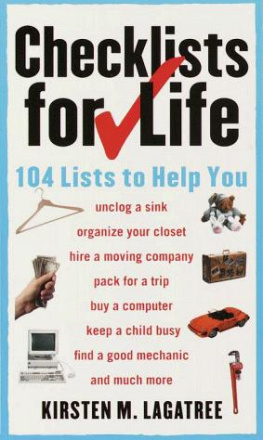A READERS DIGEST BOOK Copyright 2015 Jamie Novak All rights reserved. Unauthorized reproduction, in any manner, is prohibited. Readers Digest is a registered trademark of The Readers Digest Association, Inc. Illustrations: Ruth Yoel Library of Congress Cataloging-in-Publication Data Novak, Jamie. Keep this, toss that : unclutter your life to save time, money, space, and sanity / Jamie Novak. pages cm. pages cm.
Includes index. Summary: Quick answers to the one key question everyone needs to answer in order to get organized and save their time, money, space, and sanity: Should I keep or toss this?-- Provided by publisher. ISBN 978-1-62145-215-7 (paperback) -- ISBN 978-1-62145-216-4 (epub) 1. Storage in the home. 2. I. Title. Title.
TX309.N6856 2015 648.8--dc23 2014038314 We are committed to both the quality of our products and the service we provide to our customers. We value your comments, so please feel free to contact us. The Readers Digest Association, Inc. Adult Trade Publishing 44 South Broadway White Plains, NY 10601 For more Readers Digest products and information, visit our website: www.rd.com (in the United States) www.readersdigest.ca (in Canada) NOTE TO OUR READERS This publication contains the opinions and ideas of its author and is designed to provide useful information to the reader. It is not intended as a substitute for the advice of an expert on the subject matter covered. Products or active ingredients, treatments, and the names of organizations that appear in this publication are included for informational purposes only; the inclusion of commercial products in the book does not imply endorsement by Readers Digest, nor does the omission of any product or active ingredient or treatment advice indicate disapproval by Readers Digest.
When using any commercial product, readers should read and follow all label directions carefully. The author and publisher specifically disclaim any responsibility for any liability, loss, or risk (personal, financial, or otherwise) that may be claimed or incurred as a consequencedirectly or indirectlyof the use and/or application of any of the contents of this publication. This is dedicated to everyone who ever lost their dining room table under piles of paperwork and to those who have taken the time to share their story with me. Thank you for allowing me to do what I love.
Contents
Chapter 10:
INTRODUCTION
Are you feeling stressed by all your stuff? Let me guess: Your home is overcrowded with stuff you havent used in years, you can never find what you need, and you are feeling hopeless. Right? You want to be organized, but when your head says toss and your heart says keep, you get confused.
I get it! Making the decision about what to hold on to and what to let go of can be overwhelming. So you tell yourself youll decide about it later. The only problem is, later never comes. As a result, you end up with a houseful of stuff, and you feel like a failure. You are not a failure. (The rest is mostly just detail about where you can sell or donate stuff if you hate the idea of just tossing it.) This sets you up for decluttering disaster by leaving you without the answer to the crucial question, What should I keep, and what should I toss? As an organizing expert, this is the question I am asked most often by my personal clients and by participants in the organizing workshops I present. (The rest is mostly just detail about where you can sell or donate stuff if you hate the idea of just tossing it.) This sets you up for decluttering disaster by leaving you without the answer to the crucial question, What should I keep, and what should I toss? As an organizing expert, this is the question I am asked most often by my personal clients and by participants in the organizing workshops I present.
In fact, this is the most difficult part of the whole organizing process. This is where you need the most help. What you dont need is more elementary advice about how to label bins and baskets. You no longer have to try to figure it out alone. My easy-to-follow Keep/Toss Checklists take all the guesswork, fear, guilt, regret, and frustration out of the organizing process, even if you are a sentimentalist or a saver of stuff. And they are easily customizable to suit your space and your lifestyle.
Only you know for sure if you make waffles every Sunday and need to keep your trusty waffle iron, but I know no one needs to keep eleven non-refillable pens that no longer write! These are the obvious tosses, the items youve known you need to toss but you just havent gotten around to it yet or youve been keeping it until you can figure out how to toss it responsibly. For example, of course you should toss any kitchen utensil that has melted, bent, bubbled, warped, peeled, rusted, flaked, chipped, is dirty beyond cleaning, or cant be repaired. Ill prompt you to finally get rid of all the stuff thats been driving you crazy. Other tosses are less obvious. These are all the items youve kept out of habit, obligation, or just in case youll actually need it one day. Sometimes its simply because you dont realize you already own something similar or you havent taken the time to count just how many of the same item you own.
In this book, Ill help you determine which items are really just clutter and can therefore be tossed without regret. Oh, and by toss I dont necessarily mean throwing items into already overcrowded landfills. You can toss something by donating it, selling it, giving it away, trading it in, or recycling it. The key is to get the item out of your home, and Ill tell you how to do that thoughtfully and responsibly whenever possible. And then there are the keepers. These are the items you love or love to use regularly.
They suit your current style, make your life easier, or just make you happy! They are easy to clean, in good working order and simple to store, and oftentimes serve multiple purposes. Your keepers may not all be perfect or have all the features I mention (or even that you want) but they work for you. For instance, you might wish your vacuum cleaner had a headlight to see under spaces as you clean. But if it otherwise works for you, then you do not need to toss your vacuum cleaner to get one with a headlight. The keep/toss process is not about buying more but about looking at what you already own, considering what you really need, then keeping the best and tossing the rest.
How Do I Get Started?
Jump to the chapter that is most pressing to you.
How Do I Get Started?
Jump to the chapter that is most pressing to you.
Or read the book cover to cover, ticking off all the checklists along the way. The checklists in Chapters 1 through 4 walk you through what to keep and what to toss in the common areas of your home. In Chapters 5 through 7, I help you tackle personal items and clothing. Chapters 8 through 13 deal with general storage areas, as well as what you really need for all your hobbies and activities. Finally, in Chapters 14 through 16, youll learn how to get a handle on all the paperwork (not to mention the digital clutter weve all accumulated) in your home and office. Some of these checklists help you organize items in a specific place (your garage, for example), while others pinpoint items you use for a specifc purpose or activity (like camping gear).
Because you already have a lot going on in your life, the Keep/Toss Checklists are designed so that you can go through them at your own pace. You dont have to set aside a whole day to organize your entire bedroom (unless you want to!). You may decide to take 10 minutes to tackle one drawer on a Monday and come back to work on a closet over the weekend. The Keep/Toss Checklists shortcut every organizing project and turn what could be an hours-long process into a task that takes just minutes. Instead of deliberating about each and every item, you simply follow the list. Along the way, youll find: STORAGE SOLUTION



